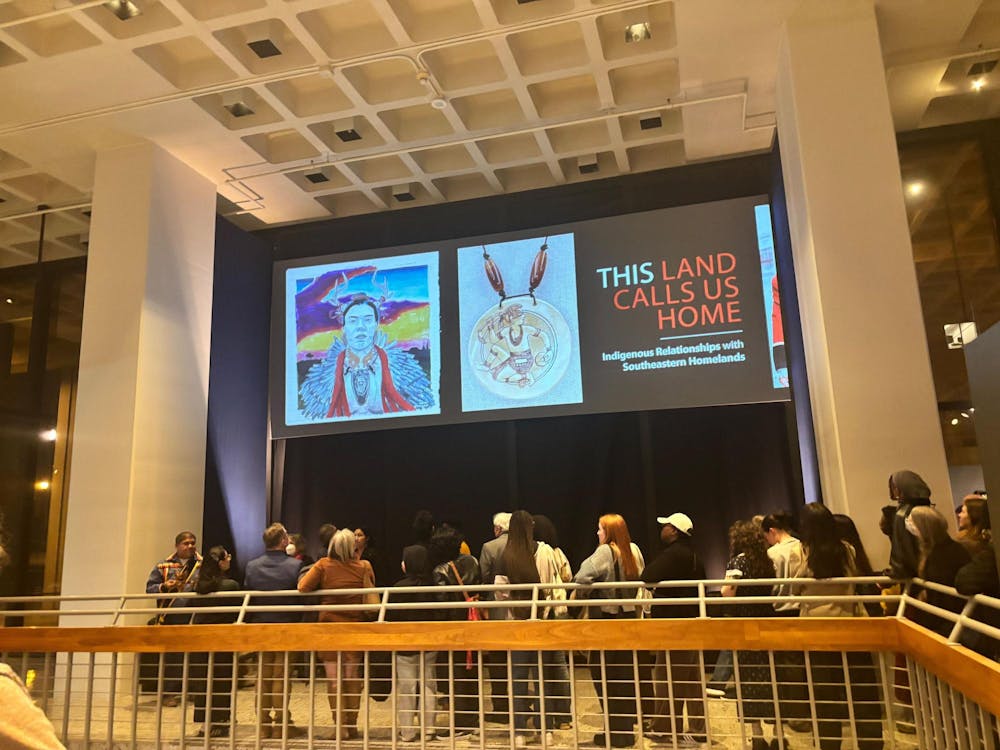The third floor of Emory University’s Robert W. Woodruff Library holds many contradictions. In the reading room, students furiously type away on their laptops, silently skim large stacks of books or intently scan their exam materials. In the middle of the floor, groups of friends and classmates gather over the large tables, transforming the space into both a social and studious environment. And on the far end of the third floor lies the Schatten Gallery, which hosts rotating exhibits created in collaboration with the Michael C. Carlos Museum, the Stuart A. Rose Manuscript, Archives, and Rare Book Library Archives and various community artists.
On Jan. 27, the Schatten Gallery unveiled its latest exhibition, “This Land Calls Us Home: Indigenous Relationships with Southeastern Homelands” with a reception in the Joseph W. Jones Room. The exhibition features over 50 works of art by contemporary Indigenous artists with ancestral homelands in the Southeast. According to the exhibition webpage, the show “suggests that these artists return to their origins, spiritually and literally, to reconstruct an identity fragmented by history.”
As 7 p.m. approached, professors, students, artists and residents from the greater Atlanta area filed into the reception where a video of a traditional Muscogee Stomp dance played. Refreshments and programs in hand, the event attendees mingled with a sense of familiarity and joy. Laughter rang through the room as they greeted each other with hugs and talked animatedly.
After Vice Provost of Libraries and Museum Valeda F. Dent delivered opening remarks, she ushered attendees into the rotunda, a circular space within the Schatten Gallery, to begin their guided tour of the exhibit.
In the rotunda, Rev. Mekko Chebon Kernell, a Seminole-Muscogee scholar who led the project, stood under the words etched onto the ceiling in Muscogee: “This is Indigenous peoples’ land.” Rev. Kernell initially conceived this project for the Hartsfield-Jackson Atlanta International Airport in 2020, where it showed from November 2023 through November 2024.
Rev. Kernell created this project out of frustration with the lack of education on Indigenous history in Atlanta. Before Europeans arrived in what is now Georgia, the land belonged to the Muscogee (Creek) people. In 1821, the Treaty of Indian Springs led the Muscogee to cede 4.3 million acres of land. The tribe then relocated from Georgia and Alabama to present-day Oklahoma following the Indian Removal Act of 1830. During the move, which is known as the Trail of Tears, thousands died on their journey westward. In 1832, there were 21,792 Muscogee living in Georgia and Alabama, but twenty years after their “removal,” only 13,537 Muscogee remained in Oklahoma.
Rev. Kernell views indigenous identity in the Southeast as part of the present, not the past, according to the exhibit’s webpage. He envisioned an art exhibit that would weave together southeast Native American history with present ties to Indigenous homelands.
As the exhibit’s year-long run in the airport ended, a member of the project team reached out to Miranda Kyle, curator of the Indigenous Arts of the Americas at the Carlos Museum, inquiring about bringing the exhibit to Emory. Kyle brought the proposal to her team, who enthusiastically supported the project’s implementation with enthusiasm.
“The logistics of it [were] reimagining what it would look like moving [the exhibit] from a concourse, behind a glass in a very liminal space like an airport, to a space where people could linger,” Kyle said.
During the opening, Alex Vigder (25C) perused the gallery. Vigder is involved with Emory’s Center for Native and Indigenous Studies, which launched in fall 2023.
“In a class I took, Indigenous literature, a lot of the students didn’t feel comfortable sharing or were nervous to participate and afraid of offending people,” Vigder said. “Whereas anyone can walk into an art exhibition and see art and appreciate its beauty and have conversations about it.”
The founding of the Center for Native and Indigenous Studies grew out of Emory’s partnership with the College of the Muscogee Nation, a public tribal community college in Oklahoma. Since that partnership began in 2021, Emory publicly acknowledged that the university was built on Muscogee lands and held three annual Muscogee teach-ins. The installation of “This Land Calls Us Home” on Emory’s campus continues these efforts.
Hailey Cade (27C) serves on the executive board of The Native American Students Association at Emory, which was chartered in fall 2024.
“It’s so empowering,” Cade said. “I feel like having a space [this exhibit] that represents me and Indigenous people on campus is really awesome, and it being in our library is super cool.”
The exhibit will remain on the Woodruff Library’s third floor until July 20. Students can wander through the many alcoves of the exhibit, examining art that transcends themes of southeastern Indigenous histories, cultures, communities and visions for the future.
“Exhibitions like this are like a hug,” Kyle said. “They go ‘There’s more beyond today, right?’”










